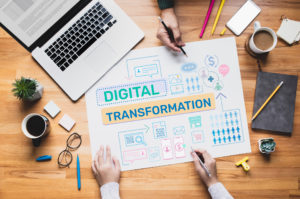What is Digital Transformation?
Digital Transformation (DT or DX) focuses on the adoption of digital technology to transform business services, practices and processes, ensuring that they are consistent, sustainable and profitable (and importantly, inspiring places to work!).
It is an essential part of your own business development demonstrating innovation, creativi ty and forward thinking as well as a key element to support your clients on their own digital transformation journey.
ty and forward thinking as well as a key element to support your clients on their own digital transformation journey.
This journey includes identifying business improvements that can be delivered through digital solutions, replacing manual processes with digital processes and automation, or refreshing older digital technology with newer digital technology. Digital transformation covers three main areas:
• Business Model Transformation – deploying digital capabilities to overhaul/supplement how your business makes or spends money to:
o react to changing customer habits
o provide deeper customer insights
o respond to a change such as Covid-19
• Organisational Transformation – identifying and implementing technology to empower your workforce while engaging and educating staff to change attitudes and adopt new practices:
o adapting to mobile working and off-site system access
o adoption of new solutions such as virtual meetings
o improving communication
• Process Transformation – reviewing processes/systems, upgrading/ changing to digital solutions, ensuring they deliver business benefits:
o going paperless
o automated billing
o real time information sharing
Where Should You Start?
Some businesses start by creating large scale strategies that take years to implement and require sizable budgets. Unless broken down into smaller phases, this approach often becomes overwhelming and unfeasible leading to the strategies often not being delivered or being overtaken by other developments.
Advising clients to take a simpler approach is usually best as small and quick wins allow for workforce buy in and clear evidencing of business benefits. This can optimise existing technology or using Agile modern development practices to build bespoke minimum-variable products in weeks (not months).
With a successful base the next phase can build on this base. This impact/evidencing approach is an effective and cost efficient start, especially for public sector and small/medium sized businesses.
Issues, Opportunities and Outcomes
The key to successful transformation is to use insights from customers and staff as well as other areas of your business to identify issues/opportunities and then identify the outcomes required.
Once identified, work back from the outcomes through ideation to identify possible solution (digital and otherwise) that tackles the issue or maximises the opportunity and provide the desired results. Most businesses have three key areas to consider:
1. Digital Transformation Strategy – a plan of action to improve the business by updating/adding new processes, enhancing workforce productivity and updating business models to leverage digital technology
2. Product Development/Build Requirement – identify opportunities/ issues and the desired outcomes required then create the digital solution
3. Implementation and Communication – once the solution is tried and tested it can be implemented with appropriate skills training and communication to ensure the solutions adoption and success
Initially it is good to look at areas such as:
• The customer journey – How do you reach them? How do they engage? What do they want? When do they want it? Are you delivering what is required? How can you improve the service?
• The staff day – What are they employed to do? Are they doing it? How can you improve their experience and ability to deliver? How can you engage with staff to identify issues and share ideas? How do you feedback on progress even when no change is required as the process in place is the most effective?
• Processes already in place – What is the current process? Is it up to date? Are there new technologies that can improve the process? Can innovation and creativity add new and more effective ways to deliver the outcomes required?
Managing Budget and Workforce Impacts
The public sector is often limited by an annual budget cycle, set out in advance with ideas only being identified at certain points in the year. To be more agile and reactive a small budget could be set aside to draw down on across the year to implement smaller projects as needed rather than relying solely on large capital investments that can take years to secure and implement.
With focus on digital solutions and automation another consideration is how to deploy the savings achieved. The public sector generally does not want to make redundancies so how can these time savings be used?
Digital transformation is often used to target the more laborious and tedious areas of the business. Automation enables staff to refocus their time on more productive and higher value services. Staff members themselves often identify areas of improvement to use the additional time that is made available.
Evidencing Digital Ability and Use of Technology
Many tenders will ask for details of digital ability and most likely you will focus on innovation and cutting edge technology, however, for the public sector tracking their spending and evidencing the delivery is also key. It is important to demonstrate your performance levels and ability to deliver value. Highlight ways to enable them to monitor how they are doing with access to self-serve portals with real time information systems etc.
Providing this level of confidence can be transformational as it gives their team the ability to demonstrate that the investment was a success and that they chose the right partner, which can lead to more business.
The New Digital Normal Post Covid-19
The current pandemic has impacted on how businesses operate. Some have reacted quickly and for others it has been a steep learning curve. All businesses have adjusted with a shift to growth, agility & innovation as the new digital normal fundamentally changing the way businesses operate.
The biggest impact areas include customer behaviour, staff relationships, online and remote working, reduced physical office space and travel required for face to face meetings. The new ways of working are likely to be adopted or integrated into a hybrid business model going forward.
Working with Partners and Agencies
When considering digital transformation there is a wide range of support available. This can range from application providers such as Apple and Google to bespoke solution creators or agencies. This support will help to navigate digital transformation journey from senior team and workforce engagement to devising a strategy, identifying issues and outcomes, building solutions, creating products, testing, reporting and implementing across the business.
The Benefits of Being a Triple Bottom Line Business
A wider transformation is happening across the business world – an increased awareness of place and planet and in 2020 an additional focus on people came to the fore. A triple bottom line is a focus on: People and Planet as well as Profit. Clients increasingly value who you are, what you stand for and your place in the world. Every business decision should be viewed through these three lenses. They do not require an equal share of importance but their consideration allows for an informed weighting i.e. this time we are putting the needs of our people first. Developing a narrative for your business gives you the ability to tell your story and differentiate yourself from your competitors.
Digital Transformation – Essential to Remaining Relevant
Digital Transformation is not just about updating or implementing digital processes. It is the opportunity to truly change and improve what you do and how you do it, freeing up valuable time for staff to focus on business priorities, higher value work and the customers who need it most. It is the work culture, practices and the attitudes of a business which are key to keeping ahead, thriving and succeeding in a digital world.
With thanks to Sam Cave-Penney, Chief of Staff Europe at Kin + Carta, a global digital transformation business
For more information, please go to:
https://www.kinandcarta.com/en/
